HONESTY
A Spark of Honesty in a World Rampant
With Pretense and Deceit
The first keyword is honesty, symbolized by the balloon flower. Although there are various theories about this flower, its first mention is widely accepted to be in a poem found in the Manyoshu, the oldest known anthology of Japanese poems from the 8th century. A poet by the name of Yamanoue no Okura wrote of a flower then called the “asagao,” counted as one of the “seven flowers of autumn.” Many Japanese will remember having to keep records of caring for asagao flowers, or morning glories, as part of elementary school homework over summer break, but apparently those asagao are a non-native species that are biologically distinct from the balloon flower. The population of the balloon flower itself has waned so much in recent years that it is designated as an endangered plant species. It is also a type of single-day flower that only blooms for a day. While it seems unfortunate that a flower that symbolizes honesty is so short-lived and at risk of extinction, one could argue that there is irony in how uncommon honesty has become in this day and age.
Being honest and sincere with other people is an important element in interpersonal relationships. When a person meets someone interesting, they will try to get a better idea of who that someone really is on the inside. Learning about the other person’s personality and thoughts on a deeper level should lead to a more substantial relationship, and there shouldn’t be any pretense at the point of meeting. Still, it’s not unusual for people to get overenthusiastic during an initial meeting and make themselves look or sound better than their usual selves. As the bestseller book Hito wa Mitame ga Kyuwari (“90% of a person is in how they look”) discusses, first impressions have a big impact and their importance can’t be ignored. This idea is supposedly based on Mehrabian’s rule, put forth in 1971 by Albert Mehrabian, a Professor Emeritus of Psychology at the University of California in the USA. The rule indicates that 90% of whether communication is successful depends on how one looks and sounds. No matter how meaningful the content might be, the unfortunate reality is that it amounts to less than 10% of how a person is evaluated. However, perhaps it is better to reserve this kind of communication for specific purposes. After all, going about every single conversation with presentation-worthy enthusiasm would tire a listener out. Being honest and sincere with yourself means others will see the unembellished version of who you really are, leading to a relationship where both sides feel comfortable but also trust each other.
With that in mind, let us look at the issue of overly enhanced selfies that make the news these days. Touching up and editing photos to make them look more appealing has long been a routine process in the advertisement and communications industry, but the innovation of internet technologies now allows nonprofessionals to do the same kind of editing with no guide as to when to stop. This enables people to post versions of themselves that are a far cry from their real selves for the world to see, which seems questionable to say the least. Of course, people may say that there’s no harm in doing it for the fun of the moment, or that some want to avoid showing their unembellished faces out of embarrassment. But consider the young person who remarked that because they only ever kept and posted edited photos, they suddenly realized one day that they had no natural photos of their friends from their school days, and couldn’t even remember what they really looked like. It was such a disheartening comment that I couldn’t help but wonder if things are getting a little out of hand.
Wanting others to see you in the best possible light is an extremely natural desire, but taking that too far can actually hurt your own self-esteem. This is because it renders a person incapable of accepting who they really are, and can consequently rob them of the opportunity to reveal their true selves. If a lightly touched-up version of yourself gets a lot of likes, you will most definitely want to step up the façade. The more this happens, the more the many-layered façade starts to stick, and once you can’t keep up that façade in real life, you start to reject who you truly are. It’s almost like a typical sci-fi story where a person’s replica is so unexpectedly superior that it takes the place of the original. Some analyses caution that this makes people lose sight of why they exist at all, potentially leading to suicide or other tragic outcomes. This kind of situation is often caused by an unhealthy dependence on the now ubiquitous smartphone or selfie editing apps.
The United States Department of Health and Human Services (HHS) warns that social media can have a “profound risk of harm” to youth mental health and calls for further research and potential restrictions. Adolescents aged ten to nineteen years old who use social media for an average of three hours a day or more tend to show more risk-taking behaviors and have a higher risk of experiencing mental health challenges such as depression. The HHS also states that “in early adolescence, when identities and sense of self-worth are forming, brain development is especially susceptible to social pressures, peer opinions, and peer comparison,” pointing out that frequent social media use may have an impact on emotional regulation and impulse control in youth and calling for more restrictions on social media content aimed at youth.
In the USA, 95% of minors aged thirteen to seventeen use social media. Many companies that operate social media platforms set the minimum age requirement to be thirteen years old, but nearly 40% of children aged eight to twelve actually use social media, and there is dire concern over mental health among youth. According to research done by the Centers for Disease Control and Prevention (CDC), which became well-known in Japan during the COVID-19 pandemic, 30% of teen girls in U.S. high schools who make frequent use of social media platforms responded that they have “seriously considered attempting suicide.” Another study shows that greater social media use leads to poor body image and low self-esteem. It may be difficult to realize that these products and services that have taken root as technology for adding enjoyment to our lives can actually trigger the growing social problem of mental health issues.
One particular brand from Cannes Lions comes to mind for addressing such issues for years under this chapter’s theme of honesty—the skincare brand Dove by Unilever. Let us first take a look at Evolution, the campaign that earned Dove the Grand Prix in the Cyber category for the 2006 Cannes Lions.
Evolution

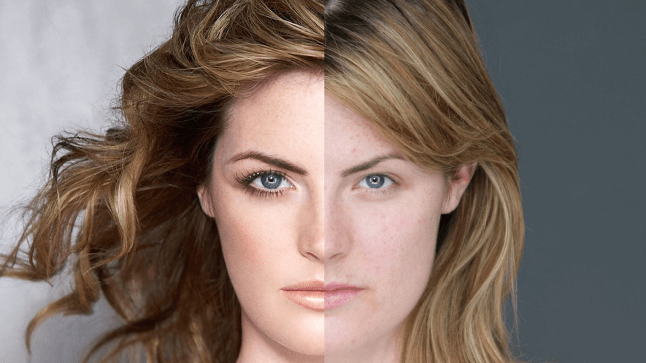
The ad uses a one minute, fourteen second time-lapse film to show the transformation of an ordinary woman you might find anywhere into an astonishingly beautiful cover model through makeup, lighting, hairdressers, and digital photoshopping of the resulting image. Dove uses the video to question the standards set by this kind of “fabricated beauty.” The video ends with the message “No wonder our perception of beauty is distorted,” purposefully asking viewers whether pursuing such beauty is really the right thing to do. It is a value that is forced on us, and the ad questions if there is any meaning in trying to pursue such ideals and that perhaps it might be better to live life with more self-confidence. At the same time, the campaign serves to declare Dove’s stance in criticizing companies that make money by perpetuating user obsession with such mistaken ideals.
Although this campaign is from 2006, when social media was just taking off and the advertisement and communications industry was slowly starting to recognize the importance of utilizing the internet, it still achieved more than 10 million views on YouTube and drove over 80 times more traffic to the campaign site. Following the Evolution campaign, Dove has constantly cast women who represent real portrayals of the times, keeping to an approach that compares the before and after images of edited beauty that flood our surroundings. Ever since, it has become something of a gimmick used frequently in campaigns all over the world, a kind of “ism” of sorts. However, I do not get the sense that the idea suffers from overuse. The layering of the same scheme tweaked to fit changing environments actually reinforces the core message and makes it more effective. Dove sticks to its principles and bolsters the message by making a series out of a themed approach, while finding ways to prevent the message from sounding tired. That is an impressive endeavor and is indicative of Dove’s sincerity and determination to see the cause through to the end.
Evolution’s success is also partly due to its clever incorporation of a trend at the time that sought to portray reality on the internet, exemplified by Burger King’s Subservient Chicken campaign that gained much attention during the 2004 Cannes Lions. The Subservient Chicken was a website set up to advertise Burger King’s new chicken sandwich product. It parodied the interactive sexcam-type peepshow that porno companies had introduced a few years prior, where users could make online requests for models on live camera to strike various poses. Instead of a porno model, the Burger King site had a man in a lingerie-clad chicken suit who responded to viewer requests. The video game-like, witty concept of this gimmick became an internet sensation, recording 1 million visits on its very first day. Dove’s campaigns also smartly incorporate contemporary insights with a sense of style that makes even similar concepts feel fresh and innovative, deftly stirring up anticipation for the next one.
My hat is off to Dove for maintaining a strong sense of purpose in its endeavors even now in 2023, always accruing more energy for generating new ideas in pursuit of the world it envisions. Seeing as their series of promoting reality has actually resulted in success, it seems evident what a strong message “being honest and sincere with yourself” is in an online environment teeming with overembellished information, and the potential it has for prompting people into action. When looking to acquire new users of a product, it will become increasingly important to not rely excessively on technology and instead engage people with sincerity and no deception.
In order to promote their endeavors, Dove in Canada also runs something called Dove Self-Esteem Workshops on a dedicated Dove Self-Esteem Fund. Self-esteem is difficult to regain once lost, and Dove provides a physical opportunity for helping people face their insecurities and having repeated conversations to find confidence in their true selves. To make sure the corporation as a whole promotes this stance, Dove’s Unilever Canada has shared the video with its 450 thousand employees via email. In putting together the case studies for this article, we got more than 100 different Japanese NPOs to cooperate in our investigation, where we found that over 60% of NPOs have not managed to set up mid-to-long-term communication activity plans, which is probably true of most regular companies as well.
Let us take a look at some more recent campaigns by Dove, starting with the 2022 Reverse Selfie.
Reverse Selfie


According to a study by Dove, many women lose their self-esteem because of certain types of information on digital media. As mentioned before, they compare themselves with the overly enhanced images of others and lose confidence, leading to a state of dejection. Consequently, 80% of young women use retouch apps (that edit photos to make eyes bigger, noses more shapely, bodies thinner, etc.) by the time they are thirteen years old. This then develops into a regular habit that becomes difficult to get out of. In other words, they get trapped in a situation where they are unable to reveal their true selves. Once that gets to be a constant routine, they get to a point where there is no going back. Dove saw the magnitude of this problem and started its Self-Esteem Project to encourage women caught in a downward spiral of losing confidence to be true to themselves. As the leading company in this endeavor, it aims to have helped a quarter billion young people around the world build their positive body image by 2030.
Younger generations these days tend to manage all of their communication in virtual spaces such as on smartphone and social media apps. Then they get caught up in the trend of the moment within their online community, dragged deeper and deeper in with no one else to consult. There is no particular problem if that virtual community is a space for positive communication, but it often presents “imposed standards of beauty” perpetuated by retouch app companies and the like. It is almost a form of intimidation. Society is also full of unreasonable assumptions about what constitutes “beauty.” Although no one knows who decided these standards, the presentation of such a concrete image of the “ultimate ideal” inevitably drives young girls to keep retouching their own images in pursuit of those unrealistic expectations. It’s important to note that these changes are not physical, and are purely digital manipulations that spread on virtual platforms like avatars. While the images are of themselves, they look very different from the original, expanding their reach with lives of their own. Then at some point they get out of control, as if the original has been taken over by their “ideal” image. However, those who suffer from this cannot escape unless they recognize the problem for themselves and understand the right steps to take, making it difficult for them to come across an effective prescription.
The Self-Esteem Project seeks to combat this issue by providing an opportunity for people to reflect on their own behaviors. In both study and business, the most effective way to understand what worked or didn’t work is to look back on one’s actions and learn from mistakes. The project takes young girls ages nine to thirteen caught in the vicious cycle of spiraling self-esteem and takes real video footage of the image retouching process they casually do on a regular basis, prompting them to think about whether the edited images truly represent who they are. The retouching process has a game-like quality that’s so amusing that one might lose track of time. But what do these girls feel when they actually see their before and after images side by side? The project has the girls question whether they can honestly say that the enhanced photos are who they actually are.
The Self-Esteem Project has run in twenty countries around the world, achieving 6 billion global impressions. It has helped teens reexamine whether excessive manipulation using filter apps to fit in with popular selfie culture is beneficial, successfully improving self-esteem and body confidence. Launching the campaign has also led to positive marketing results for Dove, with brand affinity increasing from 44% to 65%, women who felt more positive about their looks increasing from 50% to 58%, and Dove’s product sales rising by 11.9%.
This clearly proves the recent concept that brand engagement also contributes to sales. Consumers today are looking for entities that will empathize with an issue and help solve it rather than those that one-sidedly provide products. Dove’s project also goes one step further, providing parent and teacher versions of “Selfie Talk” kits to allow families and schools to identify and discuss these issues. This toolkit has been downloaded more than 40,000 times in the USA and has been calculated to have positively impacted roughly 180,000 consumers. Some schools have even adopted the kit as an educational tool.
In a sense, being honest also means exposing one’s true self. That might mean deliberately showing your unenhanced self, or unintentionally revealing that how you really look, even if you are exhausted, best represents what makes you beautiful. Now let us look at Dove’s effort to praise things the way they are, a campaign called Courage is Beautiful that was launched in March 2020 amidst the COVID-19 pandemic.
Courage is Beautiful

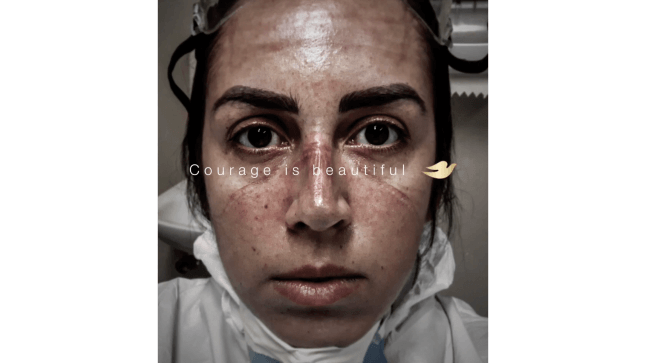
During this time, healthcare professionals worldwide worked day and night to save others from the mysterious virus, despite being at risk of contracting a disease not yet fully understood. In support, Dove donated much needed soap and hand sanitizer, where they witnessed those professionals pushing themselves to their limits working double and triple shifts. Here was the very image of the modern-day hero, and their courageous actions were the very embodiment of beauty. Truth be told, the healthcare professionals working under such extreme conditions looked worn out, grimy, and at times hollow and empty. But despite such appearances, there was beauty to be found in their determination and effort to save people regardless of the danger. The message being that beauty is not limited to physical form, and can also be conveyed through intent or actions. By showing society the healthcare professionals as they were and presenting them to the public eye, the campaign made viewers appreciate and relate to these workers, generating a positive spiral that in turn boosted the courage of the workers themselves. The campaign put the spotlight on a truth that, while not actively hidden, would never have been made public, but nevertheless deserved to be shared far and wide. Dove took it on itself to act as the medium by which to communicate this important truth as-is, with honesty and sincerity.
Dove’s sheer resolve to take on this role was impressive in itself, but the speed with which it implemented the campaign was just as remarkable. Four days after the initial idea proposal, the campaign started running in Canada and immediately spread to fifteen other countries worldwide. In just four days, they prepared footage and produced material to use in the campaign. They also purchased the necessary media outlets and organized relief efforts for actually delivering supplies to hospitals, supplying medical institutions around the world with necessities. Once the communication material featuring the faces of healthcare professionals around the globe went public, the video presenting their situation quickly garnered 2 billion views. Despite the obvious difficulties in carrying out ordinary production procedures amidst the pandemic, the campaign made use of new methods such as finding selfies on social media uploaded by the healthcare professionals themselves to use as material. They applied speed-oriented tactics such as using hashtags to search for images and contacting healthcare professionals with direct messages, and the production staff’s unhesitating attitude to try new methods demonstrates another kind of courage in itself.
The campaign was distributed globally through television, online video, print publication, outdoor signage, and PR activities. In the USA, Russia, Spain, and South Africa, the campaign cooperated with hospitals and collected data on medical worker shift patterns. On outdoor digital signage next to the busiest hospitals, the campaign showed the video in time with the beginning and end of worker shifts, managing to directly cheer on and encourage healthcare professionals working on the frontlines.
With this message, Dove garnered unprecedented engagement with 349% on Facebook, 1599% on X (formerly Twitter), and 99% likability on social media. Brand strength in major markets also got a boost, with an increase of 10 points in the USA and 5 points in the UK. The campaign also succeeded in making business contributions with brand awareness rising by 7% (USA) and 5% (UK) respectively. Analysis also shows that women in the main target audience developed a more positive attitude toward their unenhanced appearances.
Dove’s use of print media has also been superb in recent years. In the Reverse Selfie campaign, it highlights the damage from digital editing apps that set unrealistic standards of beauty. In the Courage is Beautiful campaign, it highlights the courage and actions of healthcare professionals. Given the brand’s underlying stance, perhaps it is only natural that Dove chooses print media for their campaigns. Going forward, choosing media that best reflects brand intent may become an important factor.
Finally, here are two campaigns from the 2023 Cannes Lions. Although the overall scheme remains similar, Dove takes slightly more radical measures to make them newsworthy and I would like to think about the brand’s intent going forward.
The two in question are #KeepTheGrey, which won the Social & Influencer Silver Lion, and #TurnYourBack, which won the Grand Prix and other awards in the Media Lions category.
#KeepTheGrey

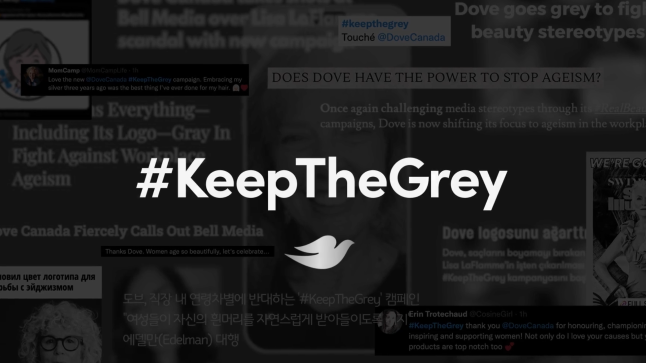
The #KeepTheGrey campaign originated when the renowned Canadian news anchor Lisa LaFlamme (58) was fired from a program she had anchored for eleven years. LaFlamme posted via video on her X (formerly Twitter) account that she was “blindsided,” and that it was “crushing to be leaving…in a manner that is not my choice.” One of the reasons for firing LaFlamme was potentially because of her hair.
Up until then she had always dyed her hair blonde, but with the COVID-19 pandemic she made the choice to stop coloring her hair and let it go gray. As she continued to deliver news with her natural hair color, the vice president of the news network she worked for allegedly asked who had approved the decision to “let Lisa’s hair go gray.” This is considered to have been a factor in the network’s decision to lay her off. The news prompted an outpour of criticism from Canada and beyond. The network has denied that the decision had anything to do with LaFlamme’s hair color, but the outcry continued. Ever committed to combat stereotypical standards of female beauty, Dove used its social media channels to launch the #KeepTheGrey campaign within just 48 hours of the news.
The objective of the campaign was to raise awareness for the double standards regarding having gray hair in the workplace. Gray hair may benefit men with the image of experience or intelligence, but women suffer from the assumption that they are “letting themselves go” or that they are not professional enough. Dove felt the need to prove the worth of women in its core user demographic, and present the important message that we need to stop the ageism and sexism women face when choosing to have gray hair. With the campaign’s launch, Dove switched its iconic logo for the first time ever from gold to gray, and urged users to show their solidarity by using grayscale versions of their profile pictures. Fifteen key influencers who supported the cause helped spread the movement through social media. This helped vitalize the discussion and earn widespread agreement from society.
Spontaneous voices of support for the campaign came in from all over. For example, the major fast food chain Wendy’s Canada changed the color of its mascot’s hair from red to gray to post on its official X (formerly Twitter) account. “#LisaLaflamme” was added to this post with the message “A [star] is a [star] regardless of hair colour” and received a lot of support on the platform. Dove replied to this with a “Looks beautiful, Wendy!” along with a #KeepTheGrey hashtag, establishing solidarity between companies and leading to a big wave for the movement.
That being said, Dove’s level of commitment can be seen beyond this ability to rally enthusiasm and support on social media. Following an announcement, it donated 100,000 dollars to a nonprofit organization that promotes better, more inclusive workplaces for women. It is easy to simply declare one’s support for a cause, but Dove makes its stance all the more convincing by actually going a step further and taking concrete corporate action. Dove’s swift response transformed the news of the dismissal of a female news anchor into a social movement that fights sexism and ageism against women.
The campaign garnered over 1 billion impressions, more than 675 global articles, and became one of the top five trending hashtags on X (formerly Twitter), making it “the most covered campaign in the history of Dove Canada.” In terms of paid media, the results delivered the most cost-efficient CPM in Dove’s history and the campaign led to more than 18,000 pieces of UGC.
In addition to the aforementioned Wendy’s, media outlets such as Sports Illustrated Swimsuit (the annual swimsuit issue of the U.S. Sports Illustrated magazine) joined in the movement, further expanding the support base. 90% of viewers felt that #KeepTheGrey brought attention to an important problem, and 89% developed a favorable impression of Dove. Although sales was outside the scope of the campaign’s objective, there was positive impact with a whole 5% rise in total sales of hair-related products during the campaign compared to the previous month. It also succeeded in generating new product rollout for Dove Canada with a new line of products formulated for gray hair in 2023.
The other campaign, #TurnYourBack, was also sparked by a piece of news.
The problem of how social media impacts mental health in youth mentioned toward the beginning of this article is becoming increasingly prominent around the world, prompting various forms of action. As of 2023, the state of Montana in the Western United States signed legislation banning TikTok, the video-sharing platform from China. Part of the law’s reasoning is due to the platform providing “dangerous content that directs minors to engage in dangerous activities.” TikTok also faced criticism regarding its handling of information during the U.S. presidential elections, and this ban probably stems from a variety of factors. However, TikTok’s globally controversial Bold Glamour filter released in 2023 was most likely a big factor in the decision.
The inner workings of the filter have not been made public, but it seems to harness AI by incorporating machine learning of countless “beautiful faces” (who decides the beauty standards aside). The Bold Glamour filter then “beautifies” features such as skin, face line, eyes, nose, and lips in real time. Perhaps due to AI, the filter works even if the face is partially obscured by a hand or other impediment, making it easier than ever to apply enhancements in virtually any situation, and more difficult to tell whether a face is embellished or not. Bold Glamour received much attention worldwide upon its release, but received severe backlash in Europe, America, and elsewhere for its damaging impact on mental health, not only for those using the filter but also for those viewing content enhanced with the filter. Dove started up a campaign to say “no” to this fabricated beauty just three days after the launch of the Bold Glamour filter.
#TurnYourBack

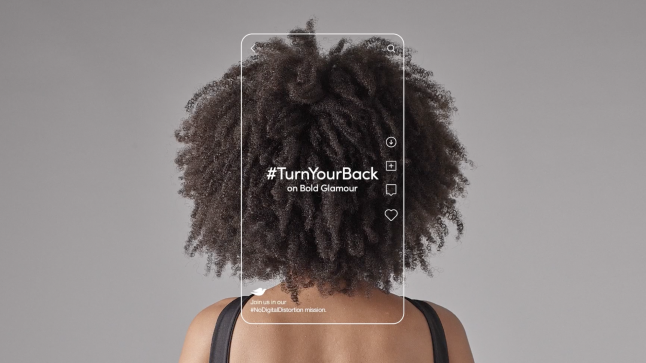
The campaign was launched in Dove’s major markets (USA, UK, Canada, France, Italy, Spain, Brazil, and South Africa). The premise was incredibly simple—to call on people to “turn their backs,” both physically and figuratively, on TikTok’s Bold Glamour filter.
The campaign also focused on raising awareness in both the young women who actually might use Bold Glamour as well as their trustworthy mothers. With cooperation from popular influencers, the campaign achieved good effective reach by cautioning mothers to reject Bold Glamour’s distortion of beauty and alerting them to the growing habit of filter use among young women with data showing its impact on mental health.
As for approaching younger users, within 72 hours of the Bold Glamour launch Dove posted “#TurnYourBack on digital distortion” on TikTok. It partnered up with sixty-eight influencers to urge more to speak out against the filter. In a video posted by actress Gabrielle Union, she talks about trying out Bold Glamour and how it made her feel before ultimately turning her back at the end. The campaign enabled the sixty-eight influencer partners to access Dove’s data on female filter use and its impact on mental health with a focus on areas that were local to each influencer, so that they could promote the campaign as a problem that was immediately relevant in each of their countries. The campaign eventually spread beyond influencers to encourage many others to join the trend.
In approaching the mothers, the campaign targeted them in the aforementioned major markets through traditional media such as OOH and newspapers. In addition, Gabrielle Union turned her back in front of media cameras at the Academy Awards venue to show her support for the campaign, and #TurnYourBack has succeeded in encouraging a wide-ranging discussion on the matter.
A look at these recent Dove campaigns seems to indicate a trend towards a bigger proportion of activism, in terms of both purpose and more active advocacy of opinion. Whether one recognizes this as a good or bad change may depend on where that person is from. The Japanese may find the tone of the 2022 Toxic Influence campaign to be a more palatable example in the sense that it doesn’t attack others or create hypothetical enemies.
Toxic Influence

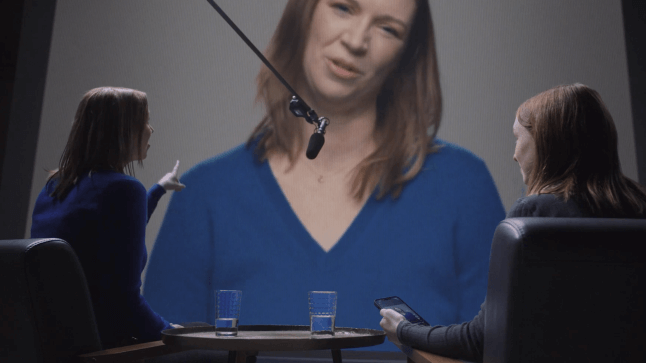
Toxic Influence aims to counter how harmful advice from online beauty influencers affect teenage girls and induce a crisis of self-esteem. Dove’s underlying intent and objective is always the same. Studies show that 92% of girls want to change the way they look, and one out of two of those girls follow these kind of influencers. Under the guise of giving advice, the influencer’s actual purpose is to sell products and services that will impart viewers with “fake beauty,” and typically begins by condemning the viewer’s current appearance. They include fear appeal in their advice, asking targets, “Are you really happy with the way you are? You could be more beautiful if you do this!”
The parents of these girls often don’t actually know that their daughters are exposed to such harmful information on a daily basis. The parents themselves make use of handy information from social media, and they assume that their daughters must also be getting beneficial information. With no parent intervention, the girls are unaware of the dangers they are exposed to, and naturally feel no need to talk to their parents about it. If this were happening in the real world, a parent would immediately step in to help if their daughter was caught by some sketchy dealer trying to exploit them on the street. However, this happens undetected online, incessantly over a long period of time, which is truly frightening to think about.
In order to bring this problem to light and provide a symbolic portrayal of the situation for wider understanding, Dove created a particular video. In it, the advice from harmful influencers that the girls hear every day are made to look like they come out of the person they trust more than anyone else in the world—their mothers—using deepfake technology. What do the mothers feel when they see themselves spouting the words that their daughters hear online? An innocuous comment would be fine, but what if those remarks were negative and made their daughters lose confidence? Some mothers who saw this immediately denied that it was them, exclaiming that they would never say such a thing or give such horrible advice. Others were too shocked to even move. The footage that captures these reactions is quite striking to see.
The backdrop that spawned this idea is the result of a user survey. The survey shows that there is a significant gap, perhaps even a disconnect, between the type of online content a parent consumes compared to their daughter. While the parent generation may be adept at discerning what information on social media they should or shouldn’t use, there is no doubt that their children still lack the experience they need to gauge whether information is reliable or not. In addition, 40% of mothers cannot name the influencers that their daughters follow, which means that they have no idea who their own children might be following online. The equivalent example in the real world would be if they had absolutely no knowledge of their children’s social lives, which would be highly worrying for a parent. In the face of such data, any parent would become concerned about letting their daughter be exposed to harmful information, but this kind of toxic relationship with social media is a daily occurrence that can be overlooked without some kind of cue.
The release of this video alerted parents to the fact that social media is constantly filled with harmful trends and manipulative words from influencers, and that their children vulnerably consume and get affected by such information. Of course, the parents are not the only ones at fault in this narrative, so Dove made sure to spare them from shame or criticism that they were not doing enough for their children by subsequently providing support to encourage conversations between parents and children, such as tools for explaining the dangers of social media and the importance of self-esteem.
A post-campaign survey shows that more than 70% of girls “felt better after unfollowing toxic beauty advice on social media,” and Dove simultaneously calls on parents to help their daughters detox their feeds. The campaign was initially launched in April 2022 in the USA, Canada, the UK, and Brazil, then later in fourteen other areas including Latin America, the EU, and South Africa, garnering 1.6 billion impressions in the USA alone and a 99% positive campaign sentiment.
While the Dove campaigns in this series under the theme of self-esteem may have individual differences in scale, duration, or target audiences, they all share the strong determination in pursuit of an ideal world. They almost feel like a reminder of that fundamental adage that the best secret to success is to persist until you succeed, but that is probably why they are so relatable and receive so much attention and support.
Now that social media use is a part of our lives, a growing need for affirmation leading to actions that seek attention solely for the purpose of posting has become commonplace. What started off as seeking affirmation for their actual selves has become a worrying tendency, where people micromanage carefully curated, fabricated avatars of themselves in a virtual world. As a result, there has been an alarming upsurge of people who end up crushed with lost confidence because they compare their real selves to their fabrications. To begin with, is there any merit to communicating with others from behind a veneer of pretense? Whether you fake your appearance or your knowledge, you will inevitably have to face the cruel consequences of having your deception revealed. Many also hesitate to engage in real-world communication because of that fear, threatening to create a vicious cycle that makes them withdraw further into their virtual worlds.
As if to counter this trend, the photo-sharing social media platform BeReal has seen an increase of downloads worldwide, particularly among Generation Z youth in the USA. The platform has no embellishing filter function of the kind you would find on the American service Instagram owned by Meta, and encourages close friends to share photos from random points in their daily lives that aren’t “Instaworthy” but serve to expose “who they really are.” As of 2022, BeReal reported 20 million daily active users. It only started gaining attention in Japan around the summer of 2022, but has since made its way into trend rankings. A year later in June 2023, 30% of university students in Japan responded that they use the app, indicating a remarkable rise in users. The success of this service remains to be seen, but we should all start by being open and honest, with the knowledge that it can lead to any number of new encounters and possibilities. Perhaps that is one of the breakthroughs we need to survive the coming age.

TRUTH
TRUTH
TRUTH
TRUTH
TRUTH
NEXT CHAPTER


A world full of
fakery masquerading as truth.